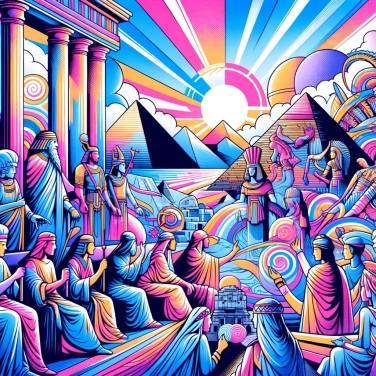The civilizations of Mesopotamia worshipped multiple deities as they attributed specific powers to each god related to aspects of daily life, such as agriculture, war, or fertility.

In Mesopotamia, each city-state had its own protective deities. Babylon, for example, primarily worshipped the god Marduk, powerful and protective; Ur favored the moon god Nanna. These local gods were seen as the masters of the city, protecting its inhabitants and ensuring daily prosperity and security. Each city jealously guarded its religious identity: having its god or goddess was somewhat like waving a flag or wearing a team jersey. These religious differences also fostered rivalry or political alliances between cities. Therefore, there was no question of limiting oneself to a single deity when each city wanted to assert its identity and defend its interests through its own specialized deities!
In Mesopotamia, the frequent whims of the Tigris and the Euphrates, two vital yet unpredictable rivers, regularly caused violent floods that destroyed villages and crops. The region also experienced brutal episodes of drought and sandstorms capable of paralyzing daily life. Faced with such unstable and unpredictable nature, people sought a reassuring explanation: creating specialized gods allowed them to attribute these uncontrollable events to clearly identifiable powers, but most importantly, potentially influenced by rites and sacrifices. Thus, worshipping multiple deities provided the inhabitants with a convenient illusion of control, to anticipate or mitigate the catastrophic effects of a chaotic climate.
In Mesopotamian times, each god had a clear specialty. For needs related to agriculture, people turned to gods like Dumuzi, who brought fertility and harvests. When it came to winning a war, it was a warrior deity like Ninurta that one would turn to. For health or in case of illness, Gula, a goddess specializing in healing, was called upon. The same goes for justice and laws: it was Shamash who was the judicial expert. As daily concerns were diverse, the Mesopotamians preferred to have many distinct deities at hand, each perfectly qualified to solve specific problems.
Mesopotamia, at the crossroads of major trade routes, was a true cultural crossroads. By exchanging with various neighboring civilizations, these peoples logically integrated influences from elsewhere into their beliefs. When merchants, travelers, and migrants brought their stories and religious practices, the local inhabitants discovered new deities and new rituals. Consequently, this sometimes resulted in composite deities or local gods enriched with legends from neighboring regions. A concrete example: the Sumerian goddess Inanna, in contact with Akkadian culture, becomes Ishtar, the goddess of love and war. Exchanges also work with religions!
The Mesopotamian peoples placed great importance on astrology. The priests were also skilled astronomers who observed the stars and planets to predict the future and understand divine will.
The ziggurats, pyramid-shaped step temples built in Mesopotamia, were considered temporary earthly dwellings for the gods, intended to bring them closer to humans.
Who was Ishtar? A true superstar in Mesopotamian mythology, she was the goddess of love, fertility... but also of war! She thus embodies the ambivalence of ancient deities.
Enki, the Mesopotamian god of freshwater, wisdom, and magic, was regarded as the primordial protector of humanity, often intervening to save mankind from harsh decisions made by other gods.
The Mesopotamian deities governed all aspects of daily life, including ensuring the fertility of the land, the protection of cities, economic prosperity, and regulating natural events. The population sought their favor through rites, sacrifices, and regular ceremonies.
The Mesopotamian peoples lived in a very unstable environment, characterized by unpredictable floods and severe droughts. To explain these phenomena, they attributed their origin to specific deities, thereby providing meaning and symbolic control over these natural events.
Yes, the Mesopotamian pantheon was strictly structured, with major deities like Anu, the god of the sky, and Enlil, the god of winds and storms, occupying the top of the hierarchy. Each major god had authority over lesser deities dedicated to various domains of action.
Trade, migration, and warfare with other regions allowed for the integration of certain deities from neighboring cultures into the Mesopotamian pantheons. This phenomenon enriched and diversified the beliefs of local civilizations, giving them increased complexity.
No, each city-state often had its own tutelary deities, although they shared some common gods like Enlil, Anu, or Inanna. Local deities could be adopted elsewhere due to cultural and political exchanges.

No one has answered this quiz yet, be the first!' :-)
Question 1/5